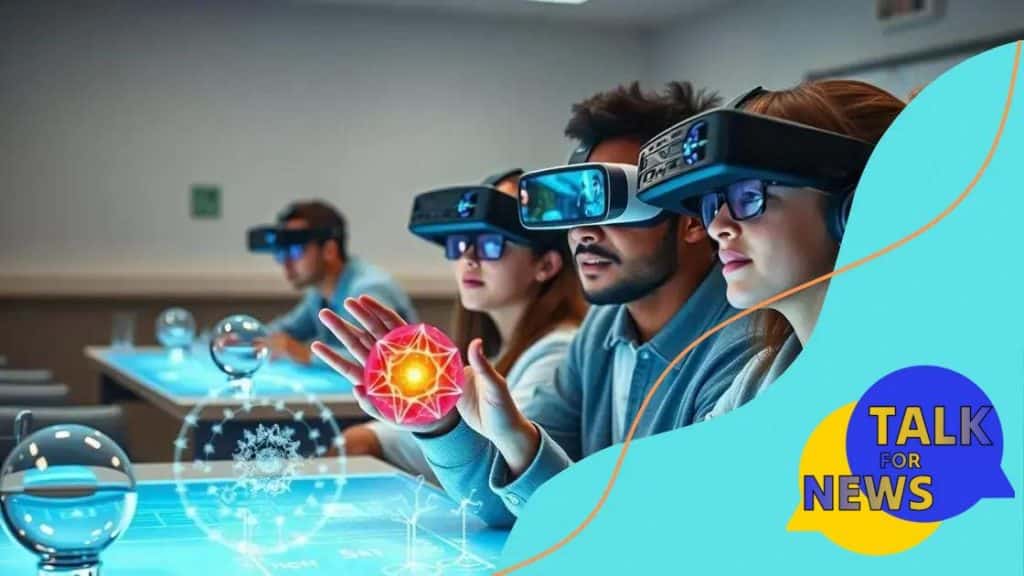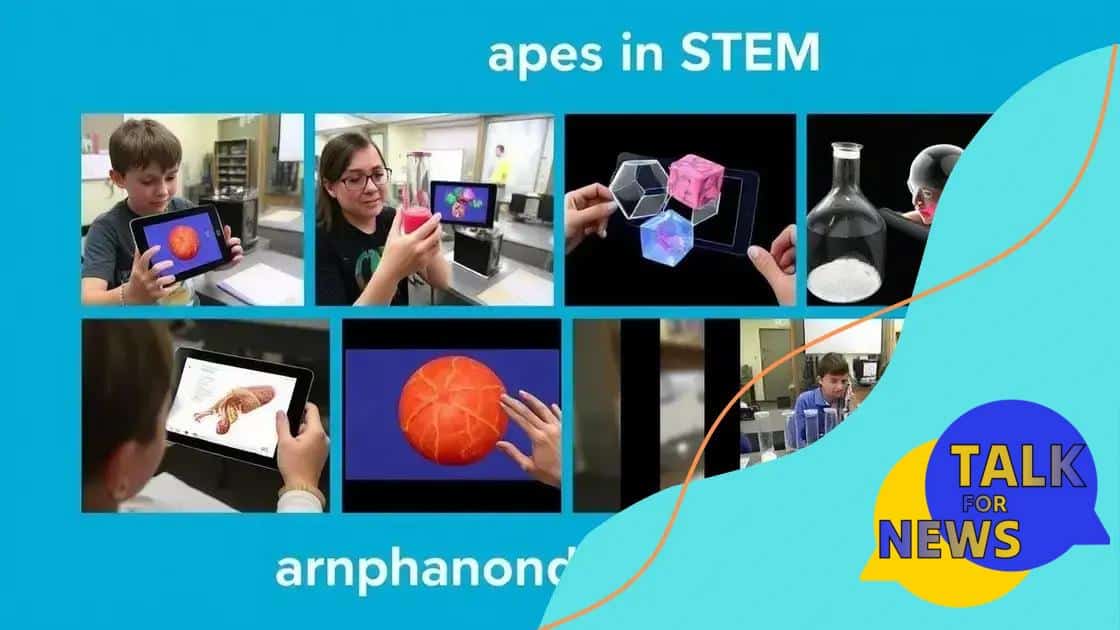The impact of augmented reality on STEM education

Anúncios
The impact of augmented reality on STEM education enhances student engagement and understanding by providing immersive, interactive experiences that make complex concepts more accessible and relatable.
The impact of augmented reality on STEM education is reshaping the learning experience for students. Imagine exploring distant planets or dissecting virtual frogs right from your classroom! This technology offers exciting ways to engage and educate.
Anúncios
Understanding augmented reality in education
Understanding augmented reality in education is vital as this technology continues to shape how lessons are delivered. It merges the real world with digital elements, allowing students to interact with information in new and engaging ways. With tools that superimpose images or data on physical environments, teachers can create dynamic experiences for students.
What is Augmented Reality?
Augmented reality, often referred to as AR, integrates digital information with the physical world. This technology enhances reality by adding layers of digital information that can be viewed through devices, such as smartphones or AR glasses. For example, students can use their devices to see 3D models of historical artifacts or scientific phenomena projected in their classroom.
Benefits of AR in Learning
Anúncios
There are many benefits of incorporating augmented reality into educational settings:
- Enhanced Engagement: Students are more likely to participate actively when using AR, as it captures their interest effectively.
- Improved Retention: Learning through interactive experiences can help students remember information better.
- Real-World Applications: AR brings complex subjects to life, making them easier to understand by providing practical examples.
By utilizing augmented reality in lessons, educators can offer students personalized learning opportunities. For instance, AR can allow students to explore anatomy by viewing organs in 3D, leading to a deeper understanding of human biology. Such experiences not only maintain student interest but also cater to different learning styles.
Moreover, as technology progresses, the usability and accessibility of augmented reality tools continue to increase. Schools can integrate AR into existing curricula without major overhauls. This adaptability allows teachers to introduce these innovative methods seamlessly.
Benefits of augmented reality in STEM
One of the most exciting aspects of incorporating augmented reality in STEM education is the vast array of benefits it offers. AR technology transforms traditional learning into an immersive experience, creating unique opportunities for students.
Increased Engagement
When students interact with 3D models and animations, their interest levels soar. Augmented reality captures attention and encourages active participation in lessons. Students are more likely to focus and retain information when it is presented in such an interactive manner.
Enhanced Understanding of Complex Concepts
STEM subjects often involve intricate theories and concepts. By visualizing these ideas, students can grasp complex topics more easily. For example, augmented reality can demonstrate chemical reactions or visualize mathematical equations, making these subjects more relatable.
- Real-life Applications: AR helps link lessons to real-world scenarios, allowing students to see the relevance of what they are learning.
- Support for Diverse Learning Styles: Whether a student learns best through visual, auditory, or kinesthetic methods, AR caters to different preferences.
- Collaboration Opportunities: AR can foster teamwork as students often work in groups to explore and solve problems together.
As students experiment with augmented reality tools, they also build critical thinking and problem-solving skills. This hands-on approach promotes deeper learning by allowing students to explore different outcomes and scenarios.
Moreover, AR technology makes STEM subjects feel more accessible. Students can visualize abstract concepts, bridging gaps in understanding and sparking curiosity. For instance, engaging with a virtual anatomy model helps students learn biology without the constraints of physical materials.
Examples of AR applications in STEM

There are numerous exciting augmented reality applications in STEM education today. These examples illustrate how this technology enhances learning, making complex subjects more understandable and engaging for students.
Virtual Labs
One popular application of AR in STEM is the creation of virtual labs. Students can conduct experiments in a safe environment, allowing them to explore concepts without the risks associated with traditional lab work. For example, they might simulate chemical reactions and observe the results without needing physical materials.
Interactive Models
Another effective use of AR is in interactive 3D models. Students can manipulate and examine models of molecules, the human body, or even solar systems. This hands-on experience helps them visualize complex structures and systems.
- 3D Anatomy Apps: Apps like Visible Body allow students to explore human anatomy in detail, viewing organs from different angles and learning how they function.
- Molecular Visualization: Programs such as MoleculAR enable students to see chemical structures in 3D, aiding in their understanding of chemistry.
- Math Applications: AR tools for math, like GeoGebra, help students visualize geometric shapes and transformations.
Additionally, some AR applications promote collaboration among students. Tools like Merge Cube allow multiple students to interact with the same AR content simultaneously. They can work together to solve problems, fostering teamwork and communication skills.
In fields like engineering, AR applications help students visualize designs and prototypes. They can overlay CAD models onto real-world environments, enhancing their understanding of how different components interact. Such tools bridge the gap between theory and practical application, making learning both relevant and exciting.
Challenges implementing AR in classrooms
Implementing augmented reality (AR) in classrooms comes with several challenges. While this technology can greatly enhance learning, there are obstacles educators must overcome to be successful.
Technical Limitations
One major challenge is the availability of reliable technology. Many classrooms lack the necessary devices, like tablets or AR glasses, which can limit accessibility for all students. Additionally, schools may struggle with inconsistent internet access, making it difficult to use AR applications effectively.
Teacher Training
Another significant hurdle is ensuring teachers are well-trained to use AR. Many educators may not be familiar with how to integrate augmented reality into their lessons. Professional development programs are essential to help teachers understand how these tools can fit into their teaching practices.
- Resource Allocation: Schools need to allocate resources for training, which can sometimes be limited.
- Ongoing Support: Teachers require continuous support after initial training to effectively use and adapt AR in their classrooms.
- Curriculum Development: There is a need to develop curricula that incorporate AR in meaningful ways, enhancing but not overwhelming existing lesson plans.
Moreover, there can be resistance from both students and parents regarding the use of new technology. Some may question its effectiveness or believe that traditional teaching methods are more reliable. It’s important to communicate the benefits of augmented reality in education, addressing any concerns with evidence and examples of successful implementations.
Finally, integrating AR into classrooms requires careful planning and collaboration among educators, administrators, and tech professionals. It’s crucial to create a supportive environment where innovation is encouraged. Without the right approach, the full potential of AR may not be realized.
Future trends of AR in educational settings
The future of augmented reality (AR) in educational settings looks promising and exciting. As technology continues to evolve, AR will play an even bigger role in classrooms, transforming how students learn.
Increased Accessibility
One of the key trends is the increased accessibility of AR tools. As mobile devices become more affordable and widespread, more students will have access to AR applications. This accessibility can lead to more inclusive learning environments, where students from various backgrounds can benefit from interactive educational experiences.
Integration with Artificial Intelligence
Augmented reality is also expected to integrate more seamlessly with artificial intelligence (AI). This combination will allow for personalized learning experiences. Imagine a classroom where AR applications adapt to each student’s learning style and progress. AI can analyze how a student interacts with AR content and provide tailored lessons accordingly.
- Smart Content: AR content may evolve to become interactive and self-updating, providing real-time information and adapting lessons based on student performance.
- Collaborative Learning: Future AR applications will likely focus on collaboration, enabling students to work together in virtual spaces regardless of their physical location.
- Gamification: Incorporating gamified elements into AR will enhance engagement, making learning feel like an adventure rather than a chore.
As AR technology continues to advance, educators will find new and innovative ways to use this tool in their courses. Schools will likely start using AR for field trips or virtual guest lectures, allowing students to experience environments and events beyond their immediate surroundings.
In addition, the development of AR glasses that are lightweight and affordable will revolutionize how students interact with their learning materials. Students may one day attend classes while wearing AR glasses that overlay information directly onto the real world, providing context and interactive instruction simultaneously.
FAQ – Frequently Asked Questions about Augmented Reality in STEM Education
What is augmented reality and how does it work in education?
Augmented reality (AR) overlays digital information onto the real world, allowing students to interact with virtual objects in their environment, enhancing the learning experience.
What are some examples of AR applications in STEM?
Examples include virtual labs for experiments, interactive 3D models for subjects like anatomy, and mathematics apps that visualize geometric concepts.
What challenges do schools face when implementing AR?
Challenges include technical limitations, lack of teacher training, and resistance to new technology from students and parents.
How will the future of AR look in educational settings?
The future of AR in education includes increased accessibility, integration with artificial intelligence for personalized learning, and more collaborative opportunities for students.





